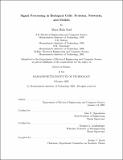Signal Processing in Biological Cells: Proteins, Networks, and Models
Author(s)
Said, Maya Rida
DownloadMaya Said TR711.pdf (15.19Mb)
Metadata
Show full item recordAbstract
This thesis introduces systematic engineering principles to model, at different levels of ab-straction the information processing in biological cells in order to understand the algorithms
implemented by the signaling pathways that perform the processing. An example of how
to emulate one of these algorithms in other signal processing contexts is also presented.
At a high modeling level, the focus is on the network topology rather than the dynamical properties of the components of the signaling network. In this regime, we examine and analyze the distribution and properties of the network graph. Specifically, we present a global network investigation of the genotype/phenotype data-set recently developed for the
yeast Saccharomyces cerevisiae from exposure to DNA damaging agents, enabling explicit study of how protein-protein interaction network characteristics may be associated with phenotypic functional effects. The properties of several functional yeast networks are also
compared and a simple method to combine gene expression data with network information is proposed to better predict pathophysiological behavior.
At a low level of modeling, the thesis introduces a new framework for modeling cellular signal processing based on interacting Markov chains. This framework provides a unified way to simultaneously capture the stochasticity of signaling networks in individual cells while computing a deterministic solution which provides average behavior. The use of
this framework is demonstrated on two classical signaling networks: the mitogen activated protein kinase cascade and the bacterial chemotaxis pathway.
The prospects of using cell biology as a metaphor for signal processing are also consid-ered in a preliminary way by presenting a surface mapping algorithm based on bacterial chemotaxis.
Description
Thesis Supervisor: Alan V. Oppenheim
Title: Ford Professor of Engineering
Thesis Supervisor: Douglas A. Lauffenbuger
Title: Whitaker Professor of Bioengineering
Date issued
2006-06-27Series/Report no.
Technical Report711